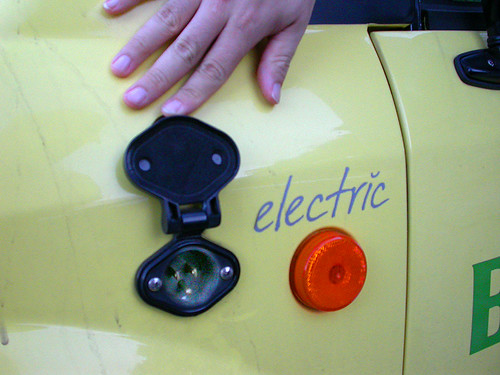
VANCOUVER — I’m on the west coast visiting some friends and exploring wonderful Vancouver. I’ve been out here almost every other year for the past 10 years and each time I visit a friend turns me onto something that catches me by surprise. On this trip, it’s the electric car.
Pictured above is my friend Alex Tu, who is an alternative energy and sustainability specialist at BC Hydro. He is also the sole driver of the utility’s only electric car. Alex is one of those late bloomers when it comes to driving — he got his license when he was 28. When he started working at BC Hydro, this experimental electric car was unused most of the time so he was encouraged to become its test driver for as long as he wanted.

While it looks pretty suave form the outside, there is absolutely no frills on the thing — the doors are as thin as the early 1990s Pontiac Firefly, the material used for the driver and passenger seats are similar to fancy lawn chairs, a dashboard does not exist, and the steering is worse than rack-and-pinion. But those are easy things to ignore when you realize that it doesn’t emit any greenhouse gases and you “refuel” the engine by plugging it into a socket. I was completely charmed when Alex flipped up the “gas tank” lid to reveal a simple household electrical outlet (pictured above).

The gear shift is as simple as it gets — its like turning on the timer for a toaster oven. And each time Alex starts the car I have no idea if its on or off as the engine is totally silent.
There are a few drawbacks: we have to drive around with the hazard lights flashing and a reflective orange safety sign hanging out of the trunk because the vehicle is not recognized as a real car — from a registration point of view, it’s classified the same way as a tractor or city utility vehicle; if it exceeds 45km/hr the vehicle automatically starts braking; and the battery life is last for only 40km.
The documentary Who Killed The Electric Car? opened my eyes to how advanced research on this type of vehicle has/did reached. Luckily, at least for my friend Alex, this type of vehicle is not extinct and may provide us with more environmentally-friendly ways to travel in the not-so-distant future.
Here’s the documentary’s trailer for those unfamiliar with the film.


14 comments
What company is behind this wicked little auto? Let’s have them manufacture more of these rides and slap on Ontario plates.
That would be these folks: http://www.itiselectric.com/
It’s not entirely true that these vehicles have zero emissions. If you get your electricity from coal, you’re probably no better off than a regular car.
Most of BC’s power comes from hydroelectric stations. The province does, however, import power at peak times. This is likely to be from fossil sources.
There’s really no such thing as a “green” car, ok?
People do like the idea of a car that charges up, as the plug-in hybrid trend demonstrates. Not to spoil the ending, but that’s the hopeful note in “Who Killed the Electric Car?”.
Not that you’d guess it from the description above.
If anyone’s laughing at the terrible performance, quality, and range of the experimental BC Hydro car, realize that it’s pretty much exactly the opposite of the GM EV-1 featured in the movie.
There are, as always, two points of concern: first, the power used has to be cleaner than what you’d get from a four-stroke gasoline engine (not as hard as it sounds); second, you need an efficient life-cycle for the batteries (some chemistries are easier to recycle than others).
Thanks for assuming we’re all stupid, Hamish.
There is no green anything, I guess. THERE IS NO GREEN HAMISH WILSON even. Nope, there isn’t.
it is difficult or near impossible to manufacture an electric car in canada.Check with transport canada and the canadian government.I remember during the toronto green environment show Al Gore approched dalton McGuinty and asked him to let a quebec electric car to be certified in ontario.It went something like”mr premier let this car be built in canada it’s great for the environment” Dalton looked embarassed and just nooded it was a funny moment indeed.
We should all press our mps’and mpps’ to do the right thing and change legislation to allow low power electric vehicles not only to be built in ontario but be certified road worthy.
What is it with dumb people who instantly jump to the coal power station slag off for EVs?? They just don’t get it.
An ICE car is at best 15% energy efficient! This is an indisputable FACT! Every petrol powered car on the road WAISTS 85% of the fuel it consumes as heat.
An EV is closer to 80% energy efficient. If you include Regenerative braking, where you recycle energy back into the batteries every time you brake, energy efficiency can increase to as much as 150%.
If you succeed in using 1/10th to 1/20th the energy to do the same work… where the power comes from is a meaningless argument!
paul>thank you for bringing facts to the scene, it’s difficult for any lay person to know who to trust or even know where to go for the facts.
The goal is for the long term vision of a clean future!
“An ICE car is at best 15% energy efficient! This is an indisputable FACT!”
Googling around pulls up sources suggesting that 20% is high as a general rule, with an outrageous maximum under ideal, designed-for conditions that still doesn’t break 40%.
“…energy efficiency can increase to as much as 150%.”
This equates to a claim of perpetual motion, with the battery being more fully charged when you get back home than it was when you left.
Consider: I use three units of energy to accelerate an impossibly efficient vehicle, and then apply equivalent braking, recovering, even more impossibly, all three units of energy. I’d call that system, which is already a perpetual motion machine, “only” 100% efficient.
Braking regeneratively and recycling the resulting electricity into big ol’ capacitors is still an efficiency win, of course, and one that’s not available to traditional cars.
I don get it either. The car does not emit toxic fumes yet people want , desperately it seems, to point out how the source of it s power is unsustainable.
It s like you quit smoking and someone says, well, that might be good but there are still smokers out there ya know.
Live Earth was a pretty good idea to promote global warming issues, yet people were bending over backwards to try and nullify the whole thing because it wasnt a purely green event in their minds.
Some people are complainers, otthers try to do stuff.
And on it goes.
I am the lucky driver of this little car, and I thought I’d add my two cents on what it’s like to drive and a couple details on costs and emissions.
This particular car is an early model built in 2002, and as Matt mentioned, there are no luxury features to speak of. But it fulfills its primary function of reliably getting me from A to B, and it is surprisingly roomy (no axle runnning down the middle of the car so there’s no hump between the seats) with lots of trunk space. I have a fast charger at my office, so I can charge the battery (about 5 kWh of energy) in about an hour, though charging at home from a 120V socket takes all night to go from empty to full. I have three complaints about the vehicle: the vehicle sometimes fails to charge when plugged in due to a poor electrical connection under the hood, which means on occasion I wake up to find my car not fully charged; the limited range, which is notionally about 40 km but practically closer to 25-30 km because at low charge the acceleration is very poor and I wonder if I could make it up the steep hills in Vancouver; and the fibreglass panels and aluminum frame are not fitted perfectly making a loud shaking noise when driving on all but the smoothest roads.
My complaints are remedied in newer plug-in hybrid prototypes currently being road-tested by most major manufacturers (better batteries; a gasoline engine as backup for extra range; and higher quality manufacturing). Just as importantly, my compaints are more than made up for by the low fuel costs and interest it generates in people intrigued by electric vehicles. As for fuel costs, a full charge of 5 kWh in BC costs about 30 cents, and I could go about 40 km on a full charge, so I’m spending less than a penny per kilometre. In contrast, a Toyota Corrola gets about 17km per litre, and at a buck per litre, that’s almost 6 cents per km. The purchase price of this car was about $12,000 in 2002.
Within BC Hydro, we have a fuel cell car, a hydrogen internal combustion engine truck and a fleet of Priuses, but nothing generates more comments from people passing by than this electric car. When stopped at an intersection, I am often signalled by other drivers to roll down my window and scream details at them about how it works and how much it costs. Surprisingly, lots of young dudes in their pickups and SUVs have mentioned how cool my ride is.
The debate about the environmental performance of these vehicles is important, and I agree it comes down to whether an expansion of these vehicles will cause an increase in coal generated electricity. In some jurisdictions, it might. But the real promise of electric transportation comes from the chance to charge these vehicles at night, during those hours when most businesses are quiet and lights are off. It is during this time when gas powered plants are off and there can be surplus renewable energy from wind power or perhaps ocean power in future that is available expressly to power the cars. This would effectively displace gasoline with renewables. This is actually an option in a place like BC, where we only have to operate our fossil fuel plants in the daytime, and at night we have extra power from small hydro plants (not the big plants with reservoirs) that we can’t store.
Electric cars should be explicitly barred from charging except at night. They should only be allowed plug into stations which are timed to disburse electricity under base load, similar to the automatic boxes that turn off airconditioners at peak times. However, that sort of base load power tends to usually come from nuclear or hydro-dam power rather than the intermittent solar, wind and tidal.
I’ve seen the film and it makes me mad that we don’t have electric cars. How bad do things have to get until we change?
Encourage everyone you know to sign this petition for the Ontario-based Zenn cars to be sold and used in Ontario.
http://www.zenncars.com/letsgo/
And here’s an article that recaps what George Sawision referred to earlier:
http://www.wheels.ca/article/2874